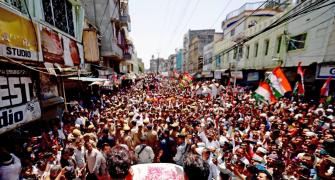The bad news for newspaper publishers -- and there are over 40,000 newspapers in India -- has just grown worse. The price of newsprint, imported or indigenous, is set to touch $1,000 per tonne, and this after a 23 per cent increase over the previous four months that took prices to $760 a tonne in March.
Factor in the April jump and newsprint prices, which typically account for 50 to 60 per cent of production costs, have risen over 60 per cent over the last six months.
"It's probably an industry first for prices to shoot up so much in less than six months," said Mohit Jain, director (business & commercial), Bennett, Coleman & Co Ltd.
To be sure, newsprint prices touched $1,000 a tonne in 1995 but the price rise was over 12 months, newspaper industry professionals recall.
The outlook for the rest of the year is bleak. "We do not expect any respite for the next six to eight months," said a newsprint importer.
The price rise has everyone worried. "Imported newsprint now costs $945 a tonne," said an astounded Sameer Kapoor, president, Metropolitan Media Company, the joint venture between Bennett, Coleman & Co Ltd and HT Media Ltd, which prints the Delhi tabloid Metro Now.
A Mumbai-based newsprint importer, who has been in the business for 35 years, admitted that good-quality paper, especially pink newsprint, is quoting over $900 a tonne.
Imported newsprint prices have been climbing since December, but what irks Gujarati daily Sandesh's Chairman Falgunbhai Chimanbhai Patel is that even Indian newsprint manufacturers have raised rates by Rs 5,000 to Rs 7,000 ($125 to $175) a tonne 'for no reason'.
Patel turned to local newsprint only in February for the 850,000 copies of Sandesh that he said he prints for Gujarat.
Local mills are milking the market simply because imported newsprint supplies have dried up. There is nothing available because manufacturing capacities in China and North America, which account for almost 40 per cent of global production, have closed for various reasons.
Newspaper industry experts said local manufacturers are also raising prices because the larger Indian publishers are turning to them for sourcing newsprint.
"They're booking huge quantities at very high rates -- some of the major English dailies are responsible for this trend," said a newsprint agent.
Bennett, Coleman's Jain, who is also chairman of newspaper committee of the Indian Newspaper Society, said such charges are baseless. "The local paper is not suited to our double-width machines," he explained.
The price rise is likely to have a bigger impact on the small and medium newspaper publishers. "The current increase will wipe out whatever profit
I have made," admitted Patel of Sandesh. Agreed Prabhat Khabar's Editor Harivansh,"We made a small profit that is likely to get affected." Prabhat Khabar prints 320,000 copies of the paper in Jharkhand.
The newsprint crunch comes at a time when a host of Indian publishers are planning new editions or products. None of them has halted plans but they admit that break-even periods will be extended.
Bennett, Coleman, for instance, is starting The Times of India edition in Chennai. Mohit Jain said the launch cannot be postponed but enthusiasm has waned on account of high input costs.
He insisted that it's not just the smaller players who are feeling the pinch. Bennett, Coleman consumes 425,000 tonnes of newsprint annually. "We use up to 22 per cent of the total newsprint consumed in India.
The leader suffers because the volume becomes a drag. We expect a major dent in profits next year," he added. Publishers are mulling various solutions to absorb the price rise. The Times of India, for one, is thinking of passing on part of the burden to the reader.
"We're very seriously exploring the option of increasing the cover price," said Jain, but did not say by how much. Dainik Bhaskar's chief financial officer P G Mishra claims that the paper is mulling similar options.
"A 50 paise hike may sound little but it improves liquidity and may even result in a 10 per cent drop in circulation -- a happy development in such times," says an industry veteran.
But that's a choice many others cannot afford to make. Prabhat Khabar already sells at Rs 3.50 and the market cannot absorb an increase, said Harivansh.
Patel said Sandesh has not increased its price for the last nine years. "We can't afford to. The market is highly competitive market with players like Gujarat Samachar and Divya Bhaskar in the fray."
Worse, the smaller players cannot afford to increase ad rates suddenly either. "More so when we can sense some kind of an economic recession looming ahead," explained the promoter of a large Hindi daily. Larger publishers, especially, in the English language space, are mulling a 15 per cent to 20 per cent increase in ad rates.
For the rest, cutting the number of pages and using paper of a lighter grammage are options. The English dailies are thinking of shifting from 45 to 42 GSM paper which save about 4 per cent on newsprint costs.
Bennett, Coleman is monitoring its freight charges as well. "We may start using 'brake bulk' rather than 'container' movement for newsprint saving about another 4 per cent," said Jain.
A delegation of Indian newspaper publishers also met the finance minister last fortnight with request to waive the 5 per cent customs duty on imported newsprint.
Experts said India's shortfall could have been worse if the global demand for newsprint had increased. Luckily, demand for newsprint in the US has declined about 10 per cent and Europe has seen a marginal increase of about 1.5 per cent.
However, India is a marginal player in global newsprint consumption. The country uses barely 2 million tonnes out of global consumption of 38.3 million tonnes, of which about 45 per cent of the requirement is met locally.








